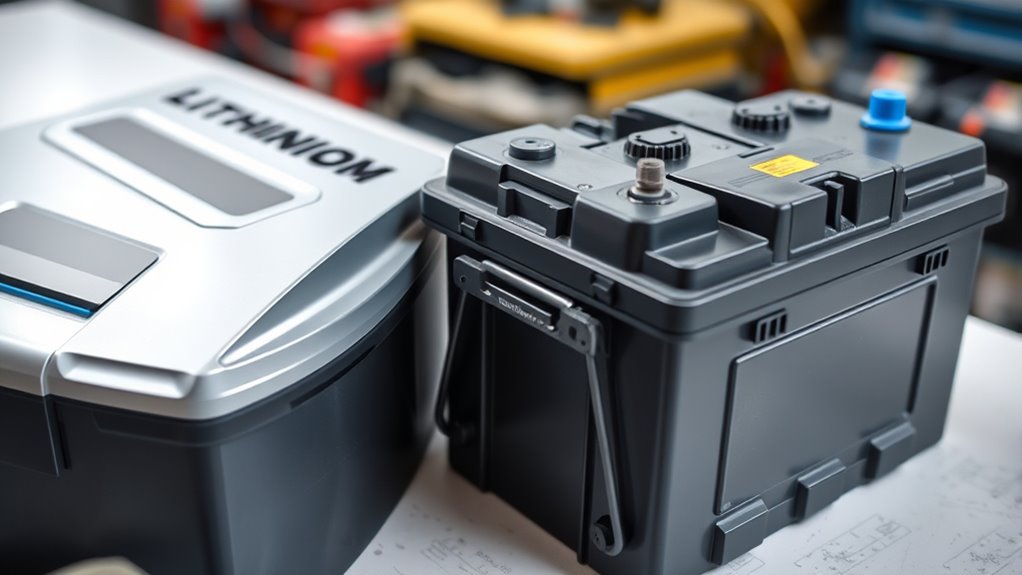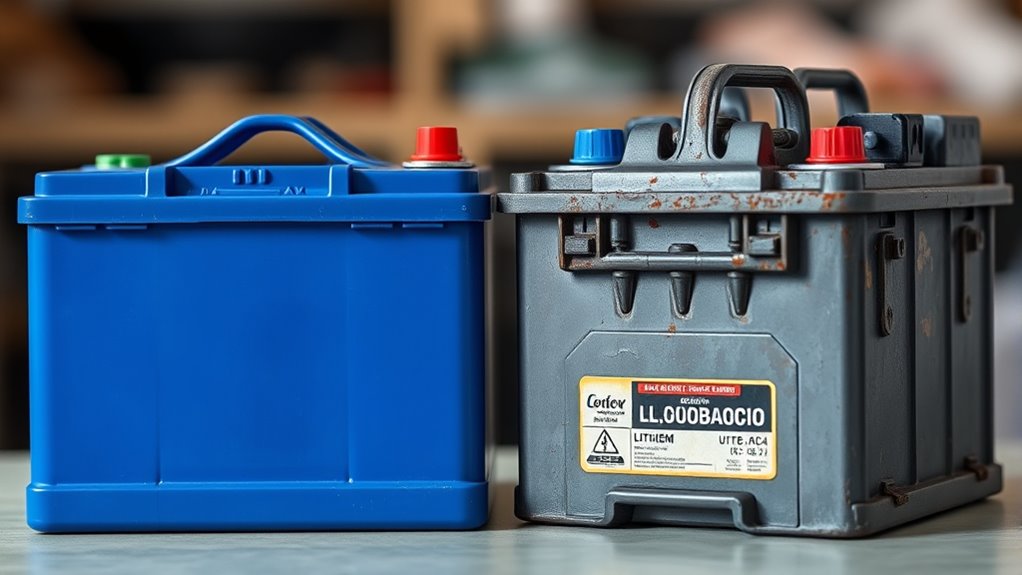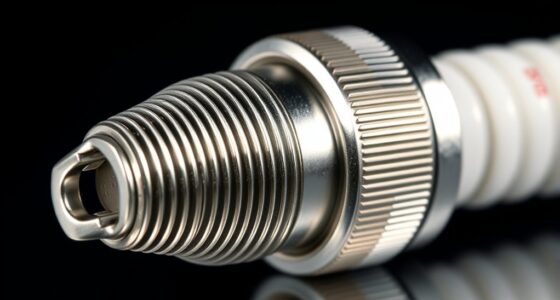When comparing lithium and lead-acid car batteries, lithium batteries last longer—about 8 to 10 years—and perform better overall, but they cost more upfront. Lead-acid batteries are cheaper initially and easier to recycle, making them more eco-friendly in the short term. However, lithium batteries pose recycling challenges and have a higher environmental impact during manufacturing. To understand which option suits your needs and their environmental implications, consider these factors carefully.
Key Takeaways
- Lithium batteries last longer (8-10 years) but have a higher initial cost compared to lead-acid batteries’ 3-5 year lifespan.
- Lead-acid batteries have a well-established recycling system, whereas lithium battery recycling is still developing.
- Lithium batteries involve more resource-intensive manufacturing and mining, increasing environmental impact.
- Lead-acid batteries are generally more sustainable due to mature recycling and lower manufacturing footprint.
- The choice depends on balancing longer lifespan and environmental concerns against higher upfront costs.

When choosing a car battery, understanding the differences between lithium and lead-acid options is essential, as each type offers distinct advantages and drawbacks. One of the key considerations is battery lifespan. Lithium batteries typically last longer than lead-acid batteries, often enduring 8 to 10 years with proper maintenance, whereas lead-acid batteries usually need replacement every 3 to 5 years. This longer lifespan can translate into lower replacement costs over time, making lithium batteries an attractive choice for those looking to reduce ongoing expenses. However, the initial investment for lithium batteries tends to be higher, which might be a barrier if you’re working with a tight budget. The overall environmental impact of each type also varies, with lead-acid batteries being more recyclable due to their established systems, while lithium batteries present more complex recycling challenges. Recycling challenges also play a significant role in your decision. Lead-acid batteries are widely recycled, with established systems in place that ensure most of the materials, especially lead and sulfuric acid, are recovered and reused safely. This mature recycling process reduces environmental impact and makes lead-acid batteries more sustainable from a waste management perspective. Conversely, lithium batteries present more complex recycling challenges. Their chemical composition and the diversity of materials used make recycling more difficult and costly. Currently, recycling infrastructure for lithium batteries is still developing, and improper disposal can pose environmental risks due to the potential release of hazardous materials. If sustainability and environmental impact are priorities for you, these recycling challenges could influence your preference toward lead-acid batteries despite their shorter lifespan. Additionally, the environmental footprint of manufacturing lithium batteries is generally higher due to resource extraction processes, such as mining for lithium, cobalt, and other rare minerals. This adds another layer to the recycling and sustainability debate. The recycling infrastructure for lithium batteries is still evolving, which impacts their environmental sustainability. Lead-acid batteries, while less environmentally intensive to produce, contain toxic substances that require careful handling during disposal or recycling to prevent soil and water contamination. Proper recycling of lead-acid batteries is well-established, which helps mitigate some of these environmental concerns.
Frequently Asked Questions
How Do Battery Recycling Processes Differ Between Lithium and Lead-Acid Batteries?
You’ll find that recycling processes differ substantially between lithium and lead-acid batteries. Lead-acid recycling is well-established, with high recycling efficiency and effective material recovery, mainly lead and sulfuric acid. In contrast, lithium battery recycling is more complex; it requires advanced methods to maximize material recovery of lithium, cobalt, and other metals, but currently has lower efficiency. Improving recycling techniques is essential for both to reduce environmental impact and conserve resources.
What Are the Environmental Impacts of Manufacturing Lithium Versus Lead-Acid Batteries?
You’re really diving into the deep end with this one. Manufacturing lithium batteries has a bigger environmental footprint due to resource extraction, especially mining for lithium, which harms ecosystems. Lead-acid batteries, while easier to recycle, produce hazardous lead waste during production. So, both have downsides, but lithium’s impact on the environment stems more from resource extraction, making it more challenging to keep the planet healthy while meeting energy needs.
How Does Temperature Affect the Performance of Lithium and Lead-Acid Car Batteries?
Temperature substantially impacts your car batteries’ performance. Lithium batteries boast better thermal stability and a wider temperature range, allowing them to operate efficiently in extreme cold or heat. In contrast, lead-acid batteries perform best within a narrower temperature range and can suffer from reduced capacity or failure in harsh conditions. If you live in a challenging climate, lithium batteries may give you more reliable performance and longevity.
Are There Safety Concerns Associated With Handling or Disposing of Either Battery Type?
You should be cautious when handling or disposing of either battery type, as safety concerns exist. Proper battery storage and handling procedures are essential to prevent leaks, fires, or chemical exposure. Lithium batteries pose a higher risk of thermal runaway, while lead-acid batteries contain hazardous acids. Always follow manufacturer instructions, wear protective gear, and dispose of batteries at designated recycling centers to guarantee safety and environmental protection.
What Advancements Are Being Made to Improve Lithium and Lead-Acid Battery Technologies?
Imagine forging a brighter future, like a blacksmith shaping new tools. You see advancements in lithium batteries extend their lifespan and lower costs through improved electrode materials and manufacturing techniques. Similarly, lead-acid batteries now feature enhanced separators and recycled components, boosting durability and affordability. These innovations aim to make both battery types more reliable and economical, helping you power your vehicle with safer, longer-lasting energy sources.
Conclusion
Ultimately, choosing between lithium and lead-acid batteries is like picking between the future and the past. Lithium batteries promise longer life, lighter weight, and faster charging—traits that seem to whisper, “Embrace tomorrow.” Meanwhile, lead-acid batteries still hold their ground as dependable and affordable. But in the race for innovation, isn’t it clear? The future belongs to those who dare to power ahead with lithium. The choice is yours—will you seize the future or cling to tradition?









